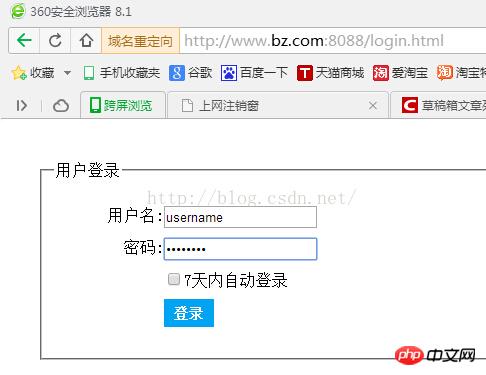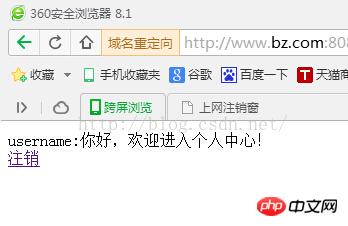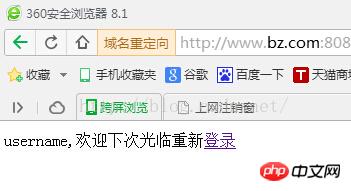PHP implementation of user login case code php example
This article mainly introduces the case code for implementing user login in PHP. The editor thinks it is quite good, so I will share it with you now and give it as a reference. Let’s follow the editor and take a look.
This article tells the case code of user login in PHP. Share it with everyone for your reference, the details are as follows:
Requirement analysis:
In web application development, it is often necessary to implement the user login function. Assume a user named username. When the user enters the homepage of the website, if he has not logged in, the page will prompt to log in. The user enters the login information for verification. If the verification passes, he enters the user center. Otherwise, the user name or password is incorrect and he needs to log in again. . After successful login, the user can also click "Logout" to return to the login page.
Programming flow chart:
login.html
##
<!DOCUMENT html PUBLIC "-//W3C//DTD XHTML 1.0 Transitional//EN" "http
://www.w3.org/TR/xhtml1/DTD/xhtml1-transitional.dtd">
<html xmlns="http://www.w3.org/1999/xhtml" xml:lang="en">
<head>
<meta http-equiv="Content-Type" content="text/html;charset=UTF-8"/>
<title>会员登录</title>
<style type="text/css">
ul li{margin:0;padding:0;}
form{margin:40px 30px 0;}
form li{list-style:none;padding:5px 0;}
form li label{float:left;width:70px;text-align:right}
form li a{font-size:12px;color:#999;text-decoration:none}
.login_btn{border:none;background:#01A4F1;color:#fff;font-size:14px;font-weight:bold;height:28px;line-height:28px;padding:0 10px;cursor:pointer;}
form li img{vertical-align:top}
</style>
</head>
<body>
<form action="login.php" method="POST">
<fieldset>
<legend>用户登录</legend>
<ul>
<li>
<label for"">用户名:</label>
<input type="text" name="username"/>
</li>
<li>
<label for"">密码:</label>
<input type="password" name="password"/>
</li>
<li>
<label for""> </label>
<input type="checkbox" name="remember" value="yes"/>7天内自动登录
</li>
<li>
<label for""> </label>
<input type="submit" name="login" value="登录" class="login_btn"/>
</li>
</ul>
</fieldset>
</body>
</html>login.php
<?php
header("Content-Type:text/html;charset=utf-8");
session_start();
if(isset($_POST['login']))
{
$username = trim($_POST['username']);
$password = trim($_POST['password']);
if(($username=='')||($password==''))
{
header('refresh:3;url=login.html');
echo "改用户名或密码不能为空,3秒后跳转到登录页面";
exit;
}
else if(($username!='username')||($password!='password'))
{
//用户名或密码错误
header('refresh:3;url=login.html');
echo "用户名或密码错误,3秒后跳转到登录页面";
exit;
}
else if(($username=='username')&&($password=='password'))
{
//登录成功将信息保存到session中
$_SESSION['username']=$username;
$_SESSION['islogin']=1;
//如果勾选7天内自动保存,则将其保存到cookie
if($_POST['remember']=="yes")
{
setcookie("username",$username,time()+7*24*60*60);
setcookie("code",md5($username.md5($password)),time()+7*24*60*60);
}
else
{
setcookie("username",'',time()-1);
setcookie("code",'',time()-1);
}
//跳转到用户首页
header('refresh:3;url=index.php');
}
}
?>
<?php
header("Content-Type:text/html;charset=utf-8");
session_start();
//首先判断Cookie是否有记住用户信息
if(isset($_COOKIE['username']))
{
$_SESSION['username']=$_COOKIE['username'];
$_SESSION['islogin']=1;
}
if(isset($_SESSION['islogin']))
{
//已经登录
echo $_SESSION['username'].":你好,欢迎进入个人中心!<br/>";
echo "<a href='logout.php'>注销</a>";
}
else
{ //为登录
echo "你还未登录,请<a href='login.html'>登录</a>";
}
?><?php
header("Content-Type:text/html;charset=utf-8");
session_start();
//清除session
$username=$_SESSION['username'];
$_SESSION=array();
session_destroy();
//清除cookie
setcookie("username",'',time()-1);
setcookie("code",'',time()-1);
echo "$username,欢迎下次光临";
echo "重新<a href='login.html'>登录</a>";
?>


## All of the above The following is the case code of PHP implementation of user login introduced by the editor. I hope it will be helpful to you. If you have any questions, please leave me a message and the editor will reply to you in time. I would also like to thank you all for your support of the php Chinese website! 
Articles you may be interested in:
ThinkPHP method to prevent repeated submission of forms Example analysis PHP example
PHP uses PDO abstraction layer to obtain query results. Example PHP skills
Analysis of PHP paging display method [Attached PHP general paging class] php skills
The above is the detailed content of PHP implementation of user login case code php example. For more information, please follow other related articles on the PHP Chinese website!

Hot AI Tools

Undresser.AI Undress
AI-powered app for creating realistic nude photos

AI Clothes Remover
Online AI tool for removing clothes from photos.

Undress AI Tool
Undress images for free

Clothoff.io
AI clothes remover

Video Face Swap
Swap faces in any video effortlessly with our completely free AI face swap tool!

Hot Article

Hot Tools

Notepad++7.3.1
Easy-to-use and free code editor

SublimeText3 Chinese version
Chinese version, very easy to use

Zend Studio 13.0.1
Powerful PHP integrated development environment

Dreamweaver CS6
Visual web development tools

SublimeText3 Mac version
God-level code editing software (SublimeText3)

Hot Topics
 1669
1669
 14
14
 1428
1428
 52
52
 1329
1329
 25
25
 1273
1273
 29
29
 1256
1256
 24
24
 PHP: A Key Language for Web Development
Apr 13, 2025 am 12:08 AM
PHP: A Key Language for Web Development
Apr 13, 2025 am 12:08 AM
PHP is a scripting language widely used on the server side, especially suitable for web development. 1.PHP can embed HTML, process HTTP requests and responses, and supports a variety of databases. 2.PHP is used to generate dynamic web content, process form data, access databases, etc., with strong community support and open source resources. 3. PHP is an interpreted language, and the execution process includes lexical analysis, grammatical analysis, compilation and execution. 4.PHP can be combined with MySQL for advanced applications such as user registration systems. 5. When debugging PHP, you can use functions such as error_reporting() and var_dump(). 6. Optimize PHP code to use caching mechanisms, optimize database queries and use built-in functions. 7
 PHP vs. Python: Understanding the Differences
Apr 11, 2025 am 12:15 AM
PHP vs. Python: Understanding the Differences
Apr 11, 2025 am 12:15 AM
PHP and Python each have their own advantages, and the choice should be based on project requirements. 1.PHP is suitable for web development, with simple syntax and high execution efficiency. 2. Python is suitable for data science and machine learning, with concise syntax and rich libraries.
 PHP and Python: Comparing Two Popular Programming Languages
Apr 14, 2025 am 12:13 AM
PHP and Python: Comparing Two Popular Programming Languages
Apr 14, 2025 am 12:13 AM
PHP and Python each have their own advantages, and choose according to project requirements. 1.PHP is suitable for web development, especially for rapid development and maintenance of websites. 2. Python is suitable for data science, machine learning and artificial intelligence, with concise syntax and suitable for beginners.
 PHP in Action: Real-World Examples and Applications
Apr 14, 2025 am 12:19 AM
PHP in Action: Real-World Examples and Applications
Apr 14, 2025 am 12:19 AM
PHP is widely used in e-commerce, content management systems and API development. 1) E-commerce: used for shopping cart function and payment processing. 2) Content management system: used for dynamic content generation and user management. 3) API development: used for RESTful API development and API security. Through performance optimization and best practices, the efficiency and maintainability of PHP applications are improved.
 The Enduring Relevance of PHP: Is It Still Alive?
Apr 14, 2025 am 12:12 AM
The Enduring Relevance of PHP: Is It Still Alive?
Apr 14, 2025 am 12:12 AM
PHP is still dynamic and still occupies an important position in the field of modern programming. 1) PHP's simplicity and powerful community support make it widely used in web development; 2) Its flexibility and stability make it outstanding in handling web forms, database operations and file processing; 3) PHP is constantly evolving and optimizing, suitable for beginners and experienced developers.
 PHP and Python: Different Paradigms Explained
Apr 18, 2025 am 12:26 AM
PHP and Python: Different Paradigms Explained
Apr 18, 2025 am 12:26 AM
PHP is mainly procedural programming, but also supports object-oriented programming (OOP); Python supports a variety of paradigms, including OOP, functional and procedural programming. PHP is suitable for web development, and Python is suitable for a variety of applications such as data analysis and machine learning.
 PHP vs. Other Languages: A Comparison
Apr 13, 2025 am 12:19 AM
PHP vs. Other Languages: A Comparison
Apr 13, 2025 am 12:19 AM
PHP is suitable for web development, especially in rapid development and processing dynamic content, but is not good at data science and enterprise-level applications. Compared with Python, PHP has more advantages in web development, but is not as good as Python in the field of data science; compared with Java, PHP performs worse in enterprise-level applications, but is more flexible in web development; compared with JavaScript, PHP is more concise in back-end development, but is not as good as JavaScript in front-end development.
 PHP and Python: Code Examples and Comparison
Apr 15, 2025 am 12:07 AM
PHP and Python: Code Examples and Comparison
Apr 15, 2025 am 12:07 AM
PHP and Python have their own advantages and disadvantages, and the choice depends on project needs and personal preferences. 1.PHP is suitable for rapid development and maintenance of large-scale web applications. 2. Python dominates the field of data science and machine learning.




